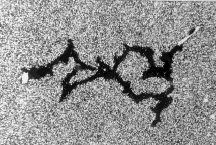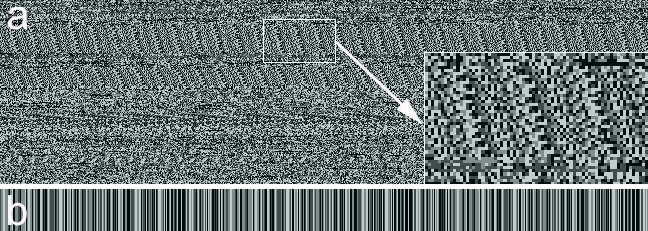PLEASE SELECT
CELL INTELLIGENCE
My experimental work during the past 30 years suggests that single tissue cells have their own data- and signal-processing capacities that help them control their movements and orientation.
Complex, yet almost identical phagokinetic
(migration) tracks of 2 sister 3T3 mouse fibroblasts
THE "FUNCTIONAL ANARCHY" OF GENOMES
Examples, based on my own work, that genome hazards which mutate genomes 'recklessly' do not wreck the genomes but, on the contrary, may create amazing genome symmetries, functions and architecture, albeit with considerable help from natural selection.
The first 170 kb of the human X-chromosome (panel a) depicted by the GPxI method
that assigns one of four
Why do genomes represent the interlacing of two complementary, fractal sets of sequences?
graytone pixels to each base (A stretch of 50 kb of un-sequenced bases are omitted). The framed section is magnified
to show that the motifs in the pattern do not repeat identically as they would in truly repetitive DNA (e.g.the computer constructed
repetitive sequence shown panel b). Instead, they are variations of
a motif.
GENOME NAVIGATION (GA-sequences and their striking properties)
How are vertebrate genomes able to find a particular gene among their several billion bases, even though the gene is encrypted in codons and fragmented into exons and introns?

Side-by-side alignment of consecutive GA-sequences by poly(A) binding proteins (PABP). The chapter presents arguments that chromatin contains numerous individual markers and 'lanes' for a rapid search mechanism.

Examples of the self-similarity of the GPxI patterns of blocks of GA-sequences ordered by size and sequence.
Guenter Albrecht-Buehler, Ph.D.
Fellow, European Academy of Sciences, Brussels
Fellow, Institute for Advanced Studies, Berlin
Robert Laughlin Rea Professor Emeritus of Cell Biology
Feinberg School of Medicine
Northwestern University, Chicago